How to Integrate Marketing Compliance into Every Area of Creative Production
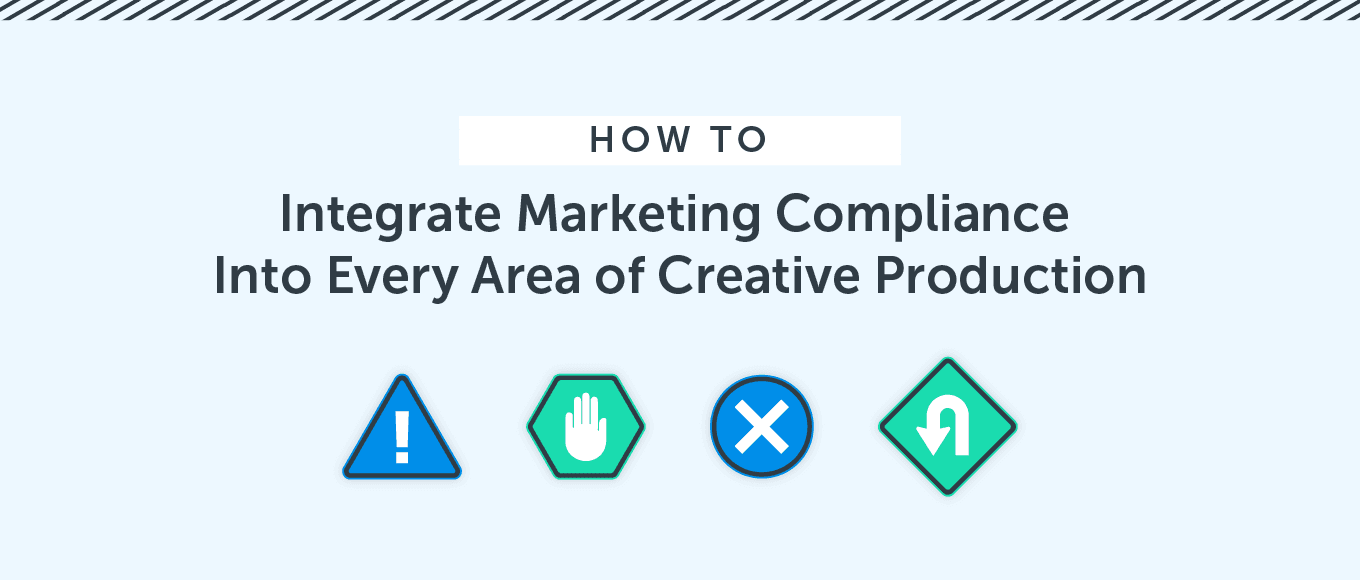 Marketing compliance: For many creative teams, “compliance” is either just one more roadblock in the constant battle to get marketing campaigns launched on time or an attempt to wrangle in rogue logo or branding use across the internet (or, let’s be honest, often inside one’s own company.)
In today’s marketing environment, however, marketing compliance has moved far beyond just trademark attribution and copyright designations. In fact, 78% of surveyed marketing teams said their work was subject to at least one type of compliance requirement. Properly managing brand integrity across channels is also growing competitive differentiator, too: today’s consumers cite brand transparency as a major purchase motivator across industries, from apparel to food to technology.
So why is actually creating compliant creative production processes such a blind spot for creative teams?
For one, marketing departments are producing more content for more marketing channels at a faster rate than ever before. Also, given the breadth and reach of today’s multi-channel campaigns, the number of stakeholders involved in sign off has the potential to increase exponentially. It’s often easier to beg for forgiveness than ask for permission (or approval).
Every day, marketing teams experience the (hopefully) healthy tension between quickly producing quality creative content across channels and ensuring that content production for all of these channels complies with internal and external brand playbooks and industry guidelines. For teams focused on pushing the envelope and chasing customer engagement across channels, ensuring compliance can be an afterthought.
Marketing compliance: For many creative teams, “compliance” is either just one more roadblock in the constant battle to get marketing campaigns launched on time or an attempt to wrangle in rogue logo or branding use across the internet (or, let’s be honest, often inside one’s own company.)
In today’s marketing environment, however, marketing compliance has moved far beyond just trademark attribution and copyright designations. In fact, 78% of surveyed marketing teams said their work was subject to at least one type of compliance requirement. Properly managing brand integrity across channels is also growing competitive differentiator, too: today’s consumers cite brand transparency as a major purchase motivator across industries, from apparel to food to technology.
So why is actually creating compliant creative production processes such a blind spot for creative teams?
For one, marketing departments are producing more content for more marketing channels at a faster rate than ever before. Also, given the breadth and reach of today’s multi-channel campaigns, the number of stakeholders involved in sign off has the potential to increase exponentially. It’s often easier to beg for forgiveness than ask for permission (or approval).
Every day, marketing teams experience the (hopefully) healthy tension between quickly producing quality creative content across channels and ensuring that content production for all of these channels complies with internal and external brand playbooks and industry guidelines. For teams focused on pushing the envelope and chasing customer engagement across channels, ensuring compliance can be an afterthought.
How to Integrate Marketing Compliance into Every Area of Creative Production
Click To TweetDOWNLOAD: 2019 State of Marketing Management Report
Curious how creative marketing teams manage their work and projects. Want to know how your own team stacks up? Download a copy of CoSchedule's 2019 State of Marketing Management and Strategy Report.What Does Marketing Compliance Mean in 2019 and Beyond?
Complying to changing FTC and GDPR regulations for multi-channel advertising is just the tip of the iceberg for a strong marketing compliance program. More importantly, marketing compliance encompasses the full internal capacity that a marketing or brand team has to comply using the systems, processes, and tools it has in place for the campaign planning, content production, and distribution and content delivery steps of a marketing campaign. Just as importantly, this capacity also extends to the actions of any brand or advertising partners coordinating campaign promotions. Yet, despite being architects of complex digital advertising campaigns, many creative teams still put up with project feedback methods that are typically problematic for auditing: email, hard copy printouts, sticky notes, etc. Using a paper trail to manage the creative process is inefficient to say the least.
Try some of our new free generators today:
Yet, despite being architects of complex digital advertising campaigns, many creative teams still put up with project feedback methods that are typically problematic for auditing: email, hard copy printouts, sticky notes, etc. Using a paper trail to manage the creative process is inefficient to say the least.
Try some of our new free generators today:
- GDPR Compliance Generator
- PCI DSS Compliance Generator
- AML Compliance Generator
- FISMA Compliance Generator
- COPPA Compliance Generator
- FINRA Compliance Generator
- FTC Compliance Generator
- ABA Compliance Generator
This One, Not That One
Even when physical or email feedback is transformed into digital assets, a versioning problem across content systems and teams quickly presents itself. Controlling content versions across systems, file formats, and collaborators makes marketing compliance a particularly challenging task. So what does a well-defined, enforceable marketing compliance strategy actually look like? For starters, marketing compliance is a set of observable (and auditable) processes across systems and projects that:- Ensures marketing content is completed in the proper manner and sequence, with proper stakeholders involved at the requisite stages.
- Protects brand integrity and consumer trust through due diligence.
- Maintains complete project records and actions across many often disconnected communication workstreams, like email, file storage systems, and project management tools.
- Facilitates a complete record of approval sign-off from all stakeholders from start to finish.
- Manages files, versions, and content in an acceptable format and location, no matter its original format or source.
- Demonstrates that content meets brand standards as well as any regulatory requirements.
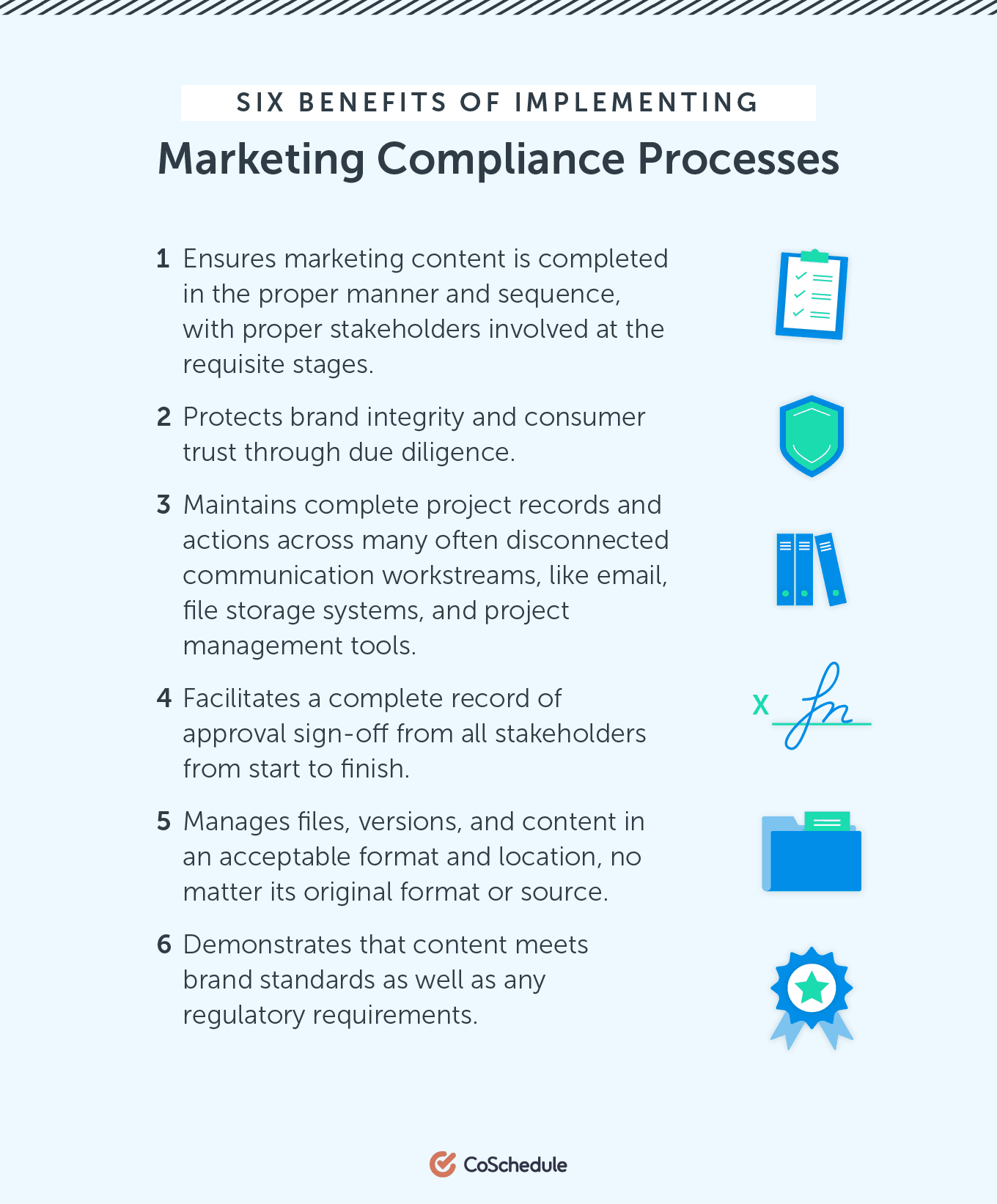
Common Compliance Gaps in Today’s Advertising Climate
It’s easy to point to major instances of fraud, financial misconduct, and false advertising as ways that brands are intentionally skirting the law and throwing due diligence out the window in order to deceive consumers or their shareholders. Yet, more often than not, it’s unintentional, simple employee actions or, more commonly, an overall lack of formal internal oversight programs, that lead to major marketing compliance headaches. It’s not ill intent—it’s simply ignorance of the interconnected controls that need to be in place. That is, until internal holes in compliance reach the public or press. Core areas of compliance risks include:Not Properly Securing Customer or Brand Data
No one wants to get hacked. But what about when the call is coming from inside the house? Many of the risks around client, consumer, and advertising data come from a breakdown in internal self-regulation. In fact, 75% of large organizations find that data breaches come not from hackers or bad actions, from simply from staff-related errors. In one example, an independent research found that marketing firm Exactics had unintentionally exposed over 340 million records on a publicly-accessible server--a completely preventable headline. As marketing data aggregators also work in the background of many apps and plugins marketing teams rely on every day, unforeseen weaknesses in data sharing between apps--and how that data is then sold—can undermine even the most diligent intentions. Combating this at a minimum should start by selecting tools and apps that offer third-party compliance verification and use endpoint security platform built for cloud systems.
Not Providing Proper Product Disclosures
False advertising has taken on new legs with multi-channel digital campaigns.For example, major agency Deutsch LA and its client Sony were slapped with a hefty fine from the FTC after running video advertisements that demonstrated remote and cross-platform features in specific games that did not end up containing those features upon the console’s launch—a major draw for consumers to buy the system. It’s not clear whether the misrepresentation was intentional or a lack of review between Sony product designers and Deutsch’s creative team. Whatever the motivation might have been, what is clear is that due diligence processes at and between the agency and its client failed to resolve the issue prior to the campaign’s distribution—and led to many partial refunds to consumers by Sony.
The FTC made it clear that even if Sony did not know about Deutsch LA’s tactics that they should have known--meaning this would not have happened with the existence of a formal agency-client review process that was clearly missing.
It’s not clear whether the misrepresentation was intentional or a lack of review between Sony product designers and Deutsch’s creative team. Whatever the motivation might have been, what is clear is that due diligence processes at and between the agency and its client failed to resolve the issue prior to the campaign’s distribution—and led to many partial refunds to consumers by Sony.
The FTC made it clear that even if Sony did not know about Deutsch LA’s tactics that they should have known--meaning this would not have happened with the existence of a formal agency-client review process that was clearly missing.
“Companies need to be reminded that if they make product promises to consumers — as Sony did with the “game changing” features of its PS Vita — they must deliver on those pledges,” Jessica Rich, Head of the FTC’s Consumer Protection Bureau.
Not Pre-Approving Brand Communications Online
Social media is the great builder and destroyer of brands. Who can forget when Oreo basically won the 2013 Super Bowl by putting up a cheeky, rapid-fire social ad referencing the broadcast blackout in a matter of minutes. It’s also easy to drum up examples of employees getting fired over committing unintentional social media faux pas on their company’s digital domains or writing inflammatory posts that don’t reflect the values of their company. Maintaining proper brand language, especially on social media, isn’t just the role and risk shouldered by social media managers or copywriters—it’s everyone’s responsibility. For example, Tesla CEO Elon Musk recently settled with the SEC over a series of misleading tweets that implied Tesla had the funding to take the company private, dramatically affect its stock prices and angering most of its shareholders. Regardless of keyboard-happy CEOs, pre-approving social content according to brand language can be especially tough to balance with the rapid, ever-flowing nature of engagement. The gold standard is a well-structured, yet agile review process that can capture social campaign content natively from each platform and route it for approval and posting in a structured fashion.
Regardless of keyboard-happy CEOs, pre-approving social content according to brand language can be especially tough to balance with the rapid, ever-flowing nature of engagement. The gold standard is a well-structured, yet agile review process that can capture social campaign content natively from each platform and route it for approval and posting in a structured fashion.
Not Being Transparent with Brand Partnerships
From the Kardashians to micro-influencers, everyone is throwing down in the brand sponsorship game. As more consumer brands leverage social media and celebrity influencers as representatives for specific, targeted campaigns, they’re wading into murky waters of representing influencers as independent consumers rather than paid spokespeople. In fact, clothing brand Lord & Taylor became one of the first brands to be sued by the FTC when it partnered with a large number of brand influencers to promote its apparel online without proper disclosure that those promotions were paid advertisements. Brand partnerships should be setting more detailed guidelines for product disclosures and product usage, but also demonstrating more structured oversight over partnership content development. The methods by which social images and copy are approved or distributed, sponsored products are labelled or tagged, and designs are licensed to co-branding partners all matters--it’s not just enough to tout the results and analytics as an effective marketing method. In all of these examples, properly following brand guidelines was only half the battle. Properly communicating them to the creative team, consumers, and brand partners--and demonstrated that that communication actually occurred—should have been a built-in part of ad and brand communication planning, creation, and review.
How Marketing Compliance Impacts Each Marketing Team Member’s Creative Production Tasks
With compliance risks coming in from every corner of the marketing ecosystem marketing compliance can no longer be just a “Send It to Legal” for review in the final stages of marketing campaign planning. Collaborative, integrated marketing campaigns means compliance needs to be baked into everyone’s daily processes from the start. Here’s what each marketing team member should be handling in their role when it comes to compliance:Creative Team (Designers, Web Developers, Copywriters, Digital Media Managers)
As the first line of content creation, the creative team is often stuck holding the bag when it comes to the administrative tasks of compliance: Saving/sourcing files properly and maintain a digital (and paper) trail of action. Often, the creative team doesn’t need more oversight, but a way to automate these daily processes in a way that won’t slow down creativity and task completion.CMOs/Leadership
Marketing leaders need to control brand cohesion and legal requirements across all marketing content channels, create a strategy for the consistent review of corporate communications, and push the envelope for new marketing technologies without exposing new data risks. Control of external partner relations—and having a birds-eye view of communication flows between partners and your creative and client teams--is imperative to feel confident in how the brand is being represented to consumers.MarTech Managers/Marketing Operations
The Marketing Operations team is ground control for managing a complex, global web of people, processes and technology that all contribute to brand integrity. The growth of marketing channels means that MarTech managers need to be even more diligent about knowing how content and data flows through internal and external systems.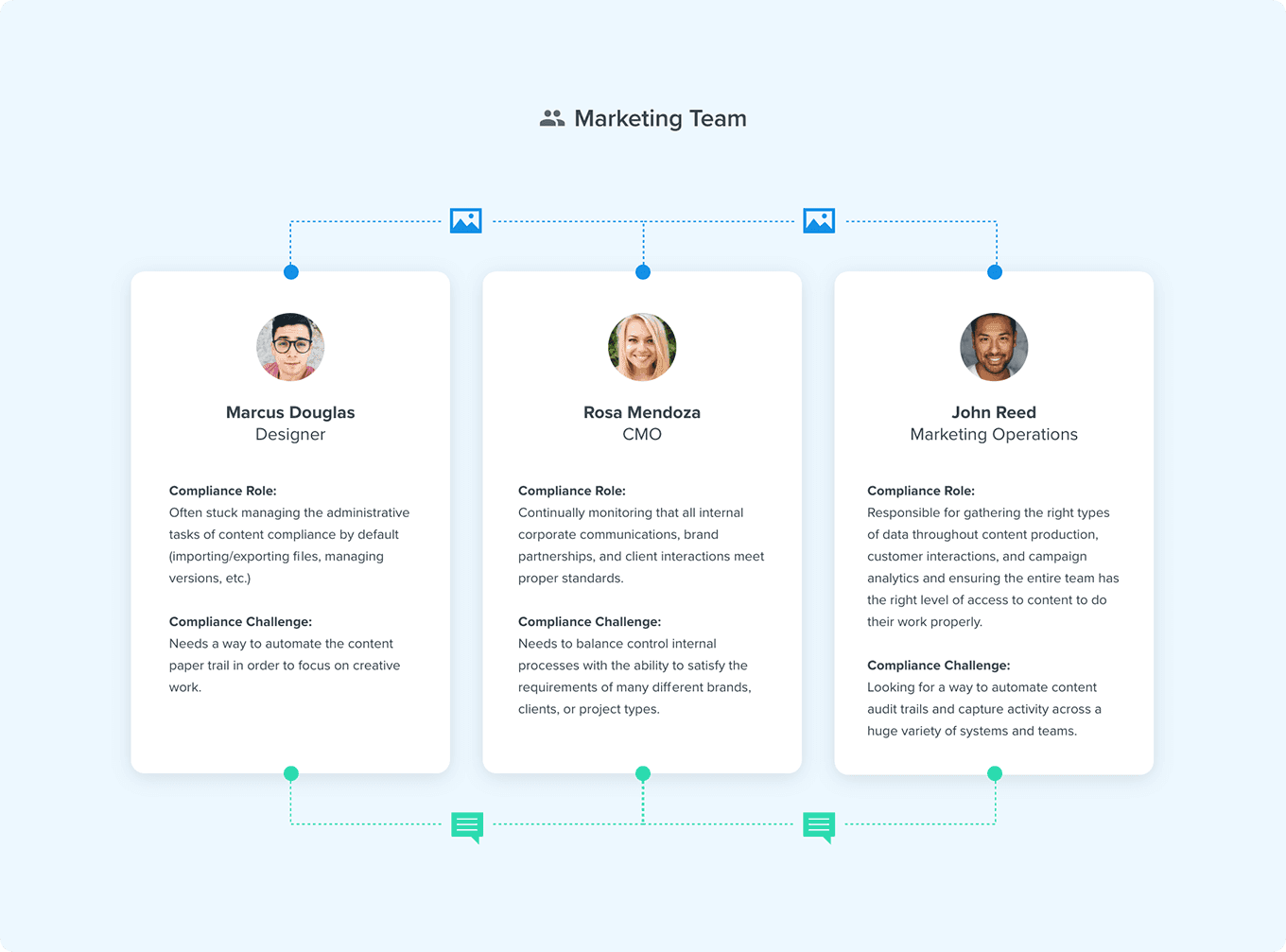
How to Integrate Compliance Oversight at the Start of Content Production
Managing compliance processes on the ground, in every daily task, gets complicated fast, especially when marketing team are juggling multiple deadlines. There are just too many multimedia content types, distribution channels, and collaborators to properly monitor gaps in communication and review via manual oversight. Standardizing oversight and minimizing risk throughout content creation requires smart integrations between content production and delivery systems that are supported by defined, automated internal-external review processes.Define and Measure Data Access Across All Campaign Contributors
No matter what content systems are in use, it’s imperative to prove who has internal and external access to source files, who can upload/create files for review, who has commenting and approval rights--and be able to track the actions of each user with accurate timestamps. That’s of course, easier said than done: marketing teams are using a host of digital advertising tools, the design team creates its version in InDesign or Photoshop, and stakeholders just want to quickly send an approval in whatever system they prefer (re: mostly email.) That’s a lot of potential data access points to keep safe—and a lot of file creation, usage, and activity to monitor. The gap between content creation and review and approval can be closed by setting up a bi-directional integration between digital asset management systems and systems in which stakeholder and client review and approval is being captured (the fewer the better, in each case.)- Intake digital assets at the point of creation and
- Configure approval actions taken on content to immediately convert final versions into assets within DAM systems.
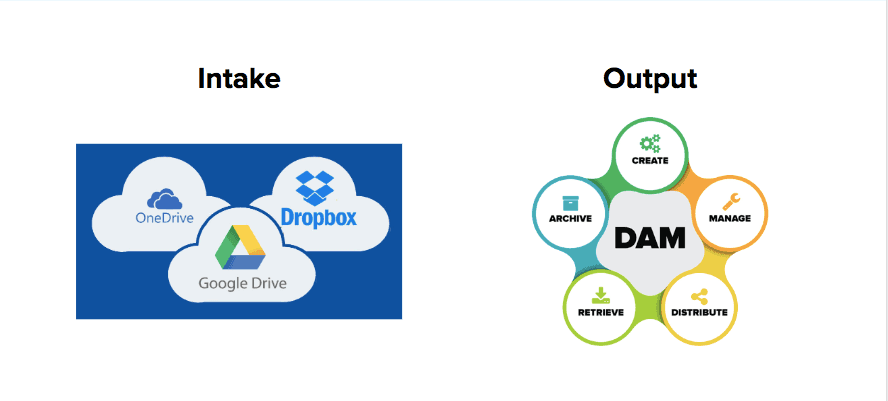
Implement Reviewer-Only Access for Client or Partner Collaboration
Other compliance complications arise when data workflows extend beyond internal review. Clients and partners often need access project versions at different points of the campaign cycle to provide input and approval and often to kick off campaigns by submitting design briefs of project versions themselves. How do you provide external collaborators with the right level of access per role without exposing them to the entire set of project files or proprietary information? It starts with defining client relationship:- Who actually owns the ‘client’ relationship and is on the hook for facilitating communication?
- What should external clients see or not see on project files?
- What are the steps for the internal sign-off workflow before sharing externally—and do you ensure those steps have been met?
- What determines a new version—a set time period for client feedback, receiving marked approval from all stakeholders, or group-based review?
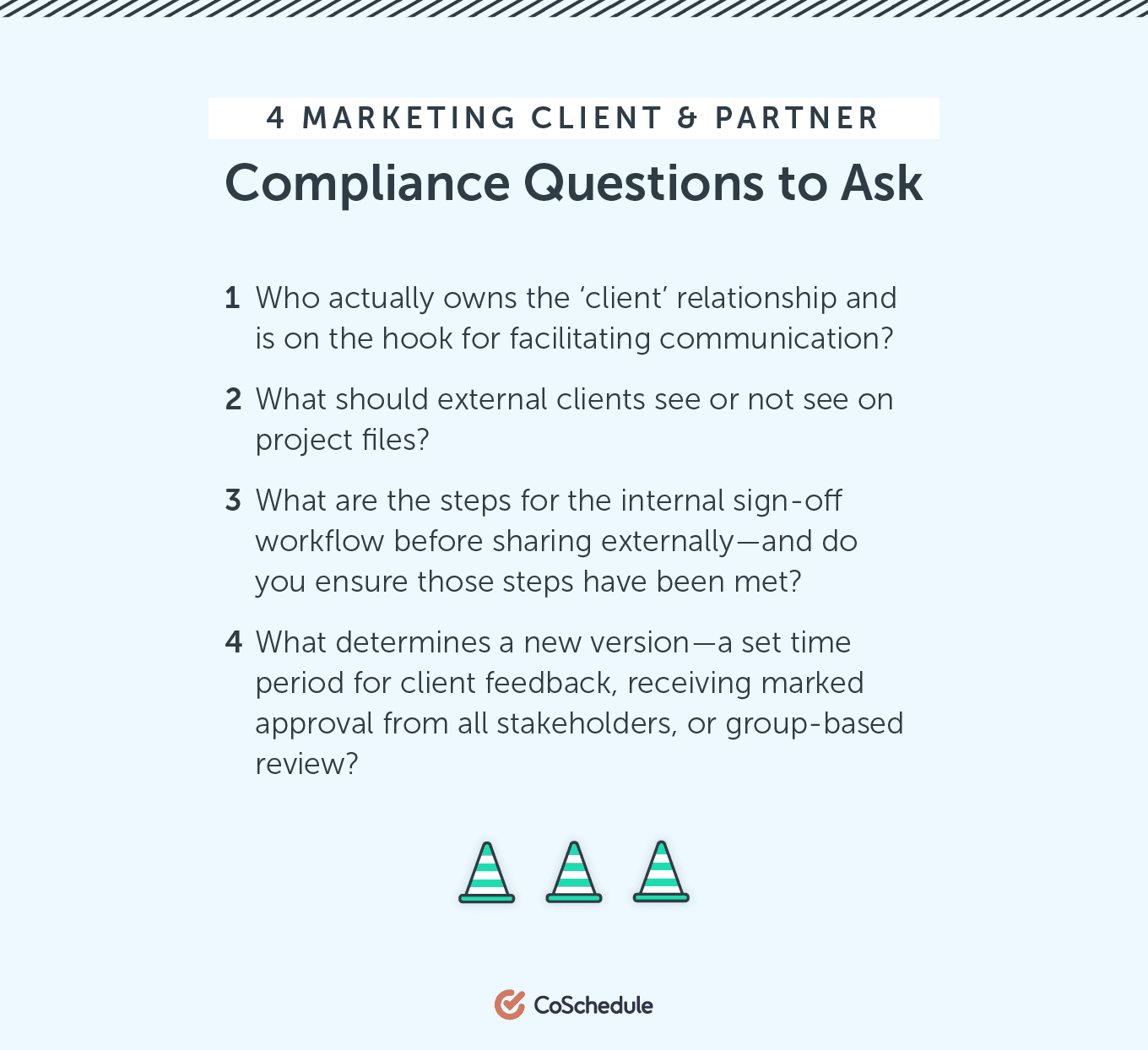 The best way to then enforce these outcomes is to then set limits for external reviewer rights in the same system you’re using for internal creative production. Setting access and modification limits for external collaborators by role, stage, or company can help turn collaboration into an untracked free-for-all into a methodical strategy for brand partnership and content security.
The best way to then enforce these outcomes is to then set limits for external reviewer rights in the same system you’re using for internal creative production. Setting access and modification limits for external collaborators by role, stage, or company can help turn collaboration into an untracked free-for-all into a methodical strategy for brand partnership and content security.
Use Stage-Based Reviews and Approvals
One of the major breakdowns in of marketing compliance is the lack of ability to prove that the right people saw creative content at the right time in the creative production process. As we saw in the case of Sony, not being able to demonstrate that Sony’s creative team had a bi-directional communication with Deutsch LA’s ad team got both companies into hot water. It’s imperative to control which users see content at each stage of production. Using a tiered review system helps move projects along, but can also be configured to ensure that further review or modifications only happen after previous approvals have been implemented and recorded. When it comes to creating a formal structure for either internal or agency-client review workflow, the #1 consideration should be visibility.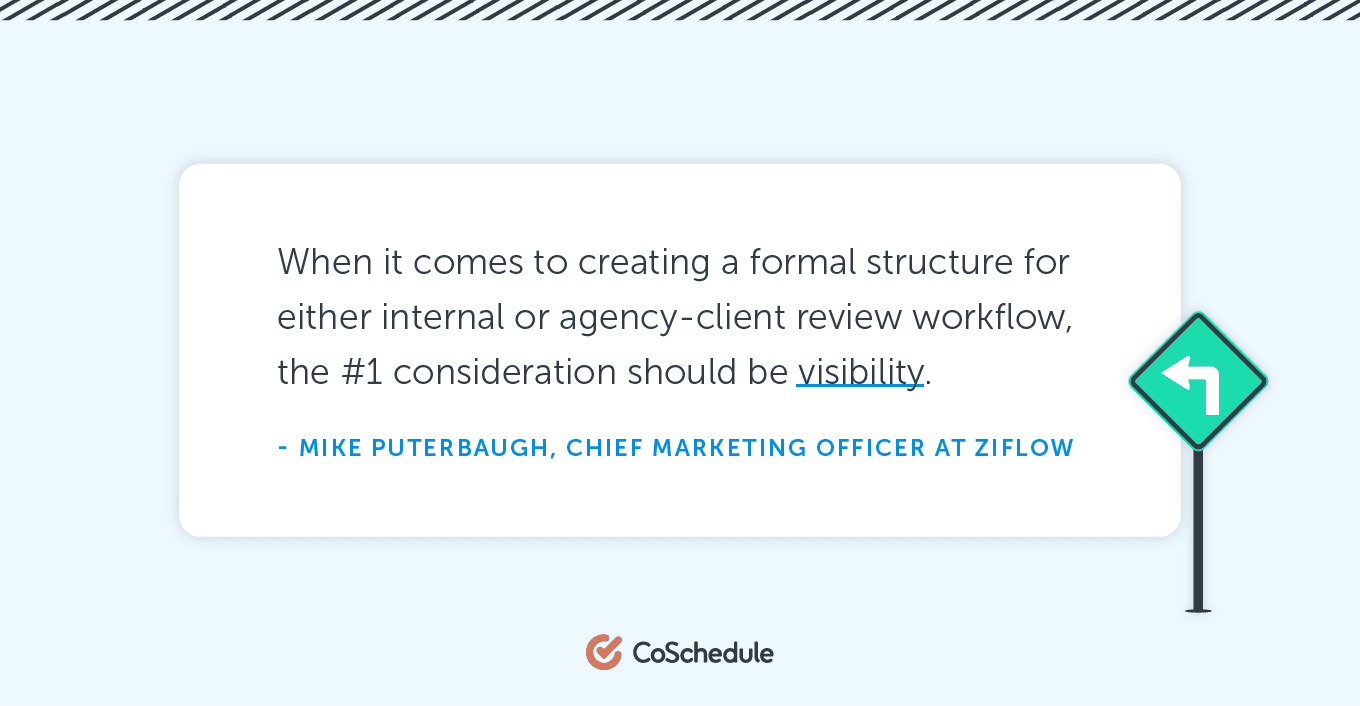 For project-heavy creative teams churning out constant deadlines, the ultimate question should be: When your team looks at an overview of multiple projects, what do you quickly want to be able to determine?
Furthermore, the stages within project review workflows should easily be categorized into two categories:
For project-heavy creative teams churning out constant deadlines, the ultimate question should be: When your team looks at an overview of multiple projects, what do you quickly want to be able to determine?
Furthermore, the stages within project review workflows should easily be categorized into two categories:
- Tasks and content version should be classified as works-in-progress.
- Points in the process when content versions be considered available for public feedback outside the creative team.
 Once you’ve decided on the right staged flow for content review, I recommend using relative deadlines to keep each stage on track. Create standards for missed deadlines--either internal or external—and hard code those rules into activity notifications.
This serves two purposes: It lights a fire under collaborators who are holding up the campaign process and demonstrates proof of communication and approval stages.
Once you’ve decided on the right staged flow for content review, I recommend using relative deadlines to keep each stage on track. Create standards for missed deadlines--either internal or external—and hard code those rules into activity notifications.
This serves two purposes: It lights a fire under collaborators who are holding up the campaign process and demonstrates proof of communication and approval stages.
Get Project Versioning Under Control
If marketing compliance boils down to one problem, it’s versioning: different stages of communication, different types of approval, and ultimately content versions. Version sprawl—especially project files stored outside of project or content management on personal drives or in email chains--simply multiplies compliance risk. Internal version sprawl starts with the first project brief. Externally, service level agreements with agency-client relationships typically set a maximum number of version, but it’s ultimately very difficult for everyone to stick with a protocol.- Distinguish between actionable feedback and commentary. Which type should spur the creation of a whole new version?
- Set a version numbering system that distinguishes between internal vs. review version.
- Determine how your versioning strategy relates to external sharing. At each stage, which collaborators should have access and approval rights to content?
Prove Brand Consistency With an Auditable Archival Method
Ensuring brand cohesion across all marketing content channels means using versioning and proper project storage throughout campaign creation. Archiving past campaigns and project briefs doesn’t just mean downloading project files into a shared Google Drive or ZIP file. For complete compliance, creative teams need to be able to export the entire history of comment, markup and version history into content repositories for historical reporting. An auditable retention strategy:- Encompass the timeline of content modification and access in addition to content files?
- Captures communication threads around marketing content tracked from the start of a project brief.
- Manages related unstructured data like social media and server data linked to static content files.
- Enables creative production data, files, and past decisions to be accessed and reviewed—with the right context—years into the past.


